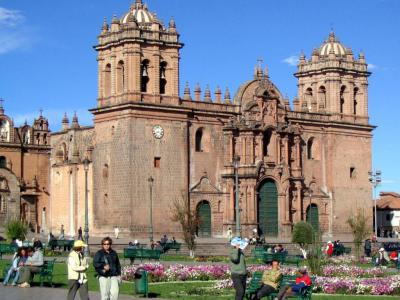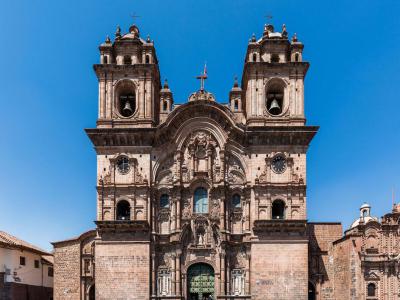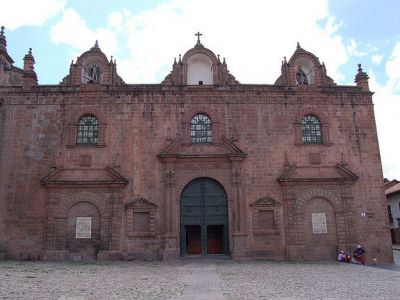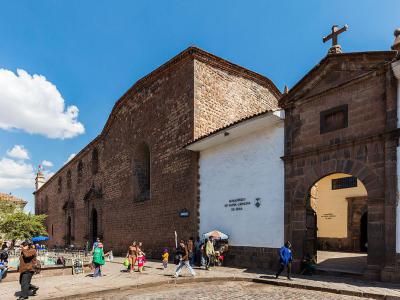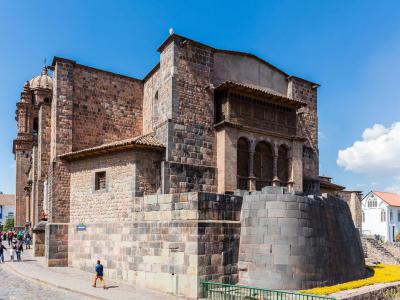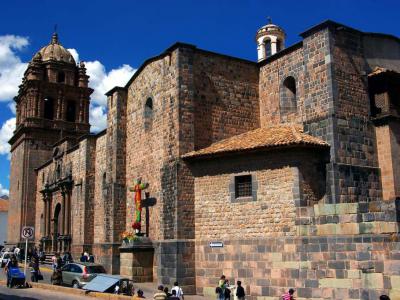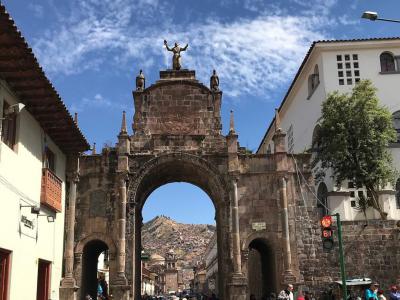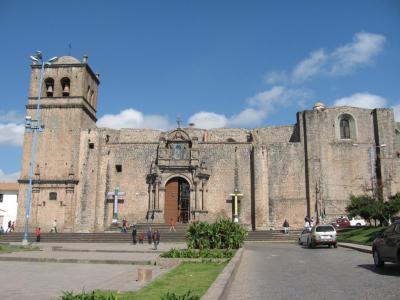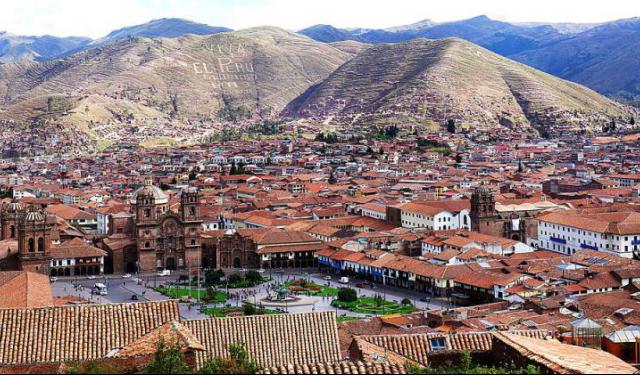Cusco's Historical Churches (Self Guided), Cusco
Cusco, the former capital of the Inca Empire, is one of the oldest cities in the world. In the 16th century, Spanish missionaries introduced the area to Catholicism. The result of that has been a plethora of historical churches built in the city since.
Among the marvels of local ecclesiastical architecture, the Cusco Cathedral reigns supreme. Constructed on the foundations of an Inca temple, this imposing cathedral showcases a blend of Spanish colonial and indigenous designs.
The Church of the Company of Jesus, characterized by its intricate facade and ornate interiors, is another gem of Cusco's religious masonry. Its Baroque style is a sight to behold, drawing visitors from around the world.
The Church of Triumph, with its stunning altars and frescoes, exudes grandeur and spirituality. Meanwhile, the Santa Catalina nunnery offers a serene retreat, where visitors can immerse themselves in contemplation amidst beautiful cloisters and gardens.
Coricancha and Convent of Santo Domingo stand as a testament to the Spanish conquest, built atop the ancient Inca temple of the sun. This juxtaposition of cultures makes it a must-visit for history enthusiasts.
The La Merced Church, with its elaborate facade and intricate carvings, showcases the fusion of Spanish and indigenous influences. Similarly, the Santa Clara Convent offers a glimpse into the life of nuns during colonial times, with its well-preserved cloisters and artworks.
Finally, the San Francisco Church and Museum provide insight into Cusco's religious and cultural history through its extensive collection of artworks and artifacts.
For those seeking to delve into the rich tapestry of Cusco's history and culture, a visit to these historical churches is highly recommended. Whether you're drawn to the architectural splendor, spiritual ambiance, or historical significance, you'll be left with a lasting impression and not be disappointed.
Among the marvels of local ecclesiastical architecture, the Cusco Cathedral reigns supreme. Constructed on the foundations of an Inca temple, this imposing cathedral showcases a blend of Spanish colonial and indigenous designs.
The Church of the Company of Jesus, characterized by its intricate facade and ornate interiors, is another gem of Cusco's religious masonry. Its Baroque style is a sight to behold, drawing visitors from around the world.
The Church of Triumph, with its stunning altars and frescoes, exudes grandeur and spirituality. Meanwhile, the Santa Catalina nunnery offers a serene retreat, where visitors can immerse themselves in contemplation amidst beautiful cloisters and gardens.
Coricancha and Convent of Santo Domingo stand as a testament to the Spanish conquest, built atop the ancient Inca temple of the sun. This juxtaposition of cultures makes it a must-visit for history enthusiasts.
The La Merced Church, with its elaborate facade and intricate carvings, showcases the fusion of Spanish and indigenous influences. Similarly, the Santa Clara Convent offers a glimpse into the life of nuns during colonial times, with its well-preserved cloisters and artworks.
Finally, the San Francisco Church and Museum provide insight into Cusco's religious and cultural history through its extensive collection of artworks and artifacts.
For those seeking to delve into the rich tapestry of Cusco's history and culture, a visit to these historical churches is highly recommended. Whether you're drawn to the architectural splendor, spiritual ambiance, or historical significance, you'll be left with a lasting impression and not be disappointed.
How it works: Download the app "GPSmyCity: Walks in 1K+ Cities" from Apple App Store or Google Play Store to your mobile phone or tablet. The app turns your mobile device into a personal tour guide and its built-in GPS navigation functions guide you from one tour stop to next. The app works offline, so no data plan is needed when traveling abroad.
Cusco's Historical Churches Map
Guide Name: Cusco's Historical Churches
Guide Location: Peru » Cusco (See other walking tours in Cusco)
Guide Type: Self-guided Walking Tour (Sightseeing)
# of Attractions: 8
Tour Duration: 1 Hour(s)
Travel Distance: 2.1 Km or 1.3 Miles
Author: Nick
Sight(s) Featured in This Guide:
Guide Location: Peru » Cusco (See other walking tours in Cusco)
Guide Type: Self-guided Walking Tour (Sightseeing)
# of Attractions: 8
Tour Duration: 1 Hour(s)
Travel Distance: 2.1 Km or 1.3 Miles
Author: Nick
Sight(s) Featured in This Guide:
- Cusco Cathedral
- Church of the Company of Jesus
- The Church of Triumph
- Santa Catalina Convent
- Coricancha and Convent of Santo Domingo
- La Merced Church
- Santa Clara Convent
- San Francisco Church and Museum
1) Cusco Cathedral (must see)
The Cusco Cathedral is part of Cusco's UNESCO World Heritage Site. The Spanish built the Cusco Cathedral between 1560 and 1654. The Roman Catholic church is Main Square's most impressive building. It has a Spanish colonial style and is home to significant colonial artworks as well as archeological finds.
The Cusco Cathedral replaced an Inca temple and was built on the temple's foundations. Many of the cathedral's stones are from the Sacsayhuamán citadel on the northern outskirts of the city. The Spanish also used the square's sacred sand in the construction. The Cusco Cathedral features a classic colonial Gothic-Renaissance style. The Spanish used conquered residents as their labor, and included some Inca symbols in the cathedral, such as the carved jaguar head on the doors.
The cathedral's north tower features the remarkable Maria Angola Bell. The bell was cast in 1659, is 2.15 meters (seven feet) high, and weighs over 13,000 pounds. The bell was named after an Angola enslaved person who added gold to the crucible when the bell was created. The bell is audible up to 20 miles away but is only rung for special occasions.
Visitors will find a collection of Peruvian painter Marcos Zapata's paintings in the sacristy. A highlight of Zapata's paintings is the fascinating "The Last Supper" showing Jesus and his disciples eating traditional Peruvian dishes such as guinea pig and and drinking chicha. Zapata was born in Cusco and was known for introducing local elements in his paintings.
In addition, the cathedral hosts portraits of Cusco's bishops. The cathedral also displays works from the Cusco School of Art. The wooden Christ of the Earthquakes crucifix is tarnished with centuries of candle smoke. The crucifix is taken outdoors during Holy Week to commemorate the 1650 earthquake.
The Cusco Cathedral replaced an Inca temple and was built on the temple's foundations. Many of the cathedral's stones are from the Sacsayhuamán citadel on the northern outskirts of the city. The Spanish also used the square's sacred sand in the construction. The Cusco Cathedral features a classic colonial Gothic-Renaissance style. The Spanish used conquered residents as their labor, and included some Inca symbols in the cathedral, such as the carved jaguar head on the doors.
The cathedral's north tower features the remarkable Maria Angola Bell. The bell was cast in 1659, is 2.15 meters (seven feet) high, and weighs over 13,000 pounds. The bell was named after an Angola enslaved person who added gold to the crucible when the bell was created. The bell is audible up to 20 miles away but is only rung for special occasions.
Visitors will find a collection of Peruvian painter Marcos Zapata's paintings in the sacristy. A highlight of Zapata's paintings is the fascinating "The Last Supper" showing Jesus and his disciples eating traditional Peruvian dishes such as guinea pig and and drinking chicha. Zapata was born in Cusco and was known for introducing local elements in his paintings.
In addition, the cathedral hosts portraits of Cusco's bishops. The cathedral also displays works from the Cusco School of Art. The wooden Christ of the Earthquakes crucifix is tarnished with centuries of candle smoke. The crucifix is taken outdoors during Holy Week to commemorate the 1650 earthquake.
2) Church of the Company of Jesus
The Church of the Company of Jesus was built on an Inca palace. Jesuits began construction on the church in 1576. The church features Spanish Baroque architecture. Its beautiful architecture influenced many other buildings later on.
The church was damaged during the 1650 earthquake and rebuilt in 1668. The church has ornate exterior and interior embellishments, such as a dramatic portal and exquisite altarpieces. The nearby Cusco Cathedral's leaders became concerned about the church's attractive features and wanted the church to tone it down so the cathedral could remain Cusco's most magnificent landmark. Pope Paul III was asked to intervene. However, his support of the cathedral didn't reach Cusco until the Church of the Company of Jesus was completed.
The Church of the Company of Jesus features several interesting artworks. Visitors will find a painting showing the wedding of Ignatius Loyola's nephew Martin Garcia de Loyola with Inca ruler Tupac Amaru's grand-niece Beatriz. Ignatius Loyola founded the Company of Jesus, and Tupac Amaru was the last Inca ruler.
The church was damaged during the 1650 earthquake and rebuilt in 1668. The church has ornate exterior and interior embellishments, such as a dramatic portal and exquisite altarpieces. The nearby Cusco Cathedral's leaders became concerned about the church's attractive features and wanted the church to tone it down so the cathedral could remain Cusco's most magnificent landmark. Pope Paul III was asked to intervene. However, his support of the cathedral didn't reach Cusco until the Church of the Company of Jesus was completed.
The Church of the Company of Jesus features several interesting artworks. Visitors will find a painting showing the wedding of Ignatius Loyola's nephew Martin Garcia de Loyola with Inca ruler Tupac Amaru's grand-niece Beatriz. Ignatius Loyola founded the Company of Jesus, and Tupac Amaru was the last Inca ruler.
3) The Church of Triumph
The Church of Triumph (Iglesia del Triunfo), located in Cusco, holds the distinction of being the first Christian church built in the city. Its construction commenced in 1536, just three years after the arrival of the Spanish conquistadors, on the city's main square. This site was historically significant, as the church was erected over Suntur Wasi, an Inca ceremonial building and armory that was connected to the palace of Wiracocha, reflecting the Spanish practice of building religious sites over indigenous structures to signify dominance and facilitate conversion.
The church's name, "Church of Triumph," commemorates a pivotal moment when the Spanish, on the brink of defeat, claimed a miraculous victory over the Incas. This victory was attributed to Saint James the Great, the patron saint of Spain, who, according to devout Catholics, descended from heaven to aid the Spanish forces. A statue within the church depicts Saint James on horseback, defeating an Inca warrior, symbolizing this legendary event.
Additionally, the church is notable for containing the vault of Garcilaso de la Vega, an esteemed Inca chronicler. Born in Cusco in 1539, de la Vega's remains were moved to the Church of Triumph in 1978 from Spain by King Juan Carlos, marking a significant repatriation of cultural heritage. De la Vega's works are crucial for understanding Inca culture and history, bridging Spanish and Andean worlds.
The Church of Triumph not only serves as a place of worship but also as a monument encapsulating the complex layers of Cusco’s history, from its Inca foundations to its colonial transformations.
The church's name, "Church of Triumph," commemorates a pivotal moment when the Spanish, on the brink of defeat, claimed a miraculous victory over the Incas. This victory was attributed to Saint James the Great, the patron saint of Spain, who, according to devout Catholics, descended from heaven to aid the Spanish forces. A statue within the church depicts Saint James on horseback, defeating an Inca warrior, symbolizing this legendary event.
Additionally, the church is notable for containing the vault of Garcilaso de la Vega, an esteemed Inca chronicler. Born in Cusco in 1539, de la Vega's remains were moved to the Church of Triumph in 1978 from Spain by King Juan Carlos, marking a significant repatriation of cultural heritage. De la Vega's works are crucial for understanding Inca culture and history, bridging Spanish and Andean worlds.
The Church of Triumph not only serves as a place of worship but also as a monument encapsulating the complex layers of Cusco’s history, from its Inca foundations to its colonial transformations.
4) Santa Catalina Convent
The Santa Catalina Convent in Cusco is a historic church and convent with an intricate history spanning over four centuries. Founded in 1605, it is built on the ruins of Acllawasi, an Inca institution dedicated to virtuous members of the nobility who worshiped the sun god. The nuns who lived here participated in ceremonies, weaving, and the preparation of sacred bread and beer. After significant damage by a 1650 earthquake, the convent was promptly rebuilt starting in 1651, and renovations continue to this day.
The architecture of Santa Catalina Convent is a standout example of Mudejar design, characterized by beautifully painted arches and a remarkable chapter house adorned with murals. The chapel showcases Baroque frescoes that uniquely incorporate Inca motifs of vegetation. This blending of styles extends to the convent's impressive collection of religious art, one of the finest in the region since 1975, featuring Amerindian and Spanish influences. Notable works include anonymous paintings depicting the Lord of the Earthquakes and pieces by esteemed local artists like Marcos Ribera, Francisco Padilla, and Diego Quispe Tito. The collection also boasts paintings of Santa Rosa de Lima's life and miracles, as well as nine chasubles intricately embroidered with precious metals.
A unique artifact within the convent is a trunk that contains a small-scale model of the life of Jesus. Historically, this trunk was used by Catholic Church representatives who traveled across remote Peruvian regions to evangelize the local populations. Additionally, visitors can purchase homemade marzipan crafted by the nuns, adding a personal touch to the visit.
The architecture of Santa Catalina Convent is a standout example of Mudejar design, characterized by beautifully painted arches and a remarkable chapter house adorned with murals. The chapel showcases Baroque frescoes that uniquely incorporate Inca motifs of vegetation. This blending of styles extends to the convent's impressive collection of religious art, one of the finest in the region since 1975, featuring Amerindian and Spanish influences. Notable works include anonymous paintings depicting the Lord of the Earthquakes and pieces by esteemed local artists like Marcos Ribera, Francisco Padilla, and Diego Quispe Tito. The collection also boasts paintings of Santa Rosa de Lima's life and miracles, as well as nine chasubles intricately embroidered with precious metals.
A unique artifact within the convent is a trunk that contains a small-scale model of the life of Jesus. Historically, this trunk was used by Catholic Church representatives who traveled across remote Peruvian regions to evangelize the local populations. Additionally, visitors can purchase homemade marzipan crafted by the nuns, adding a personal touch to the visit.
5) Coricancha and Convent of Santo Domingo (must see)
The Coricancha, "Golden Temple" or sometimes "Temple of the Sun," was the most important temple in the Inca Empire. Unfortunately, most of the temple was destroyed by Spanish conquistadors, but the remaining stonework was used to make the foundation of the Santo Domingo Convent.
You'll notice many variations of spelling used for "Coricancha" since there is no single agreed-upon English spelling. A few alternatives that you'll see include Qorikancha and Koricancha.
The Inca used ashlar masonry to construct Coricancha. This alone is a testament to the building's importance since ashlar is labor intensive and requires the use of only perfectly faced and squared stones.
At one time, the walls of Coricancha were covered in gold, and the courtyards were filled with gold statues. The Spanish described the opulence as "fabulous beyond belief." In 1533, the Spanish demanded a gold ransom for the Inca leader Atahualpa's life. Most of the gold came from Coricancha. A nearby archaeological museum has a collection of mummies, idols, and textiles from the site.
The Spanish eventually built the Convent of Santo Domingo on the site. Some of the stones from Coricancha were used for the foundation, and others found their way into other churches around town.
The convent was the first Dominican convent in Peru. It was founded in 1534, and the first building was completed in 1610. Unfortunately, a severe earthquake caused an earlier structure to collapse completely.
The building you see today was built in 1680. The baroque bell tower was added in the early 1700s. The museum here is divided into four areas: the Coricancha, the Cusco School, a contemporary art collection, and a collection of work collected by the convent to recognize modern works made in the city of Cusco.
You'll notice many variations of spelling used for "Coricancha" since there is no single agreed-upon English spelling. A few alternatives that you'll see include Qorikancha and Koricancha.
The Inca used ashlar masonry to construct Coricancha. This alone is a testament to the building's importance since ashlar is labor intensive and requires the use of only perfectly faced and squared stones.
At one time, the walls of Coricancha were covered in gold, and the courtyards were filled with gold statues. The Spanish described the opulence as "fabulous beyond belief." In 1533, the Spanish demanded a gold ransom for the Inca leader Atahualpa's life. Most of the gold came from Coricancha. A nearby archaeological museum has a collection of mummies, idols, and textiles from the site.
The Spanish eventually built the Convent of Santo Domingo on the site. Some of the stones from Coricancha were used for the foundation, and others found their way into other churches around town.
The convent was the first Dominican convent in Peru. It was founded in 1534, and the first building was completed in 1610. Unfortunately, a severe earthquake caused an earlier structure to collapse completely.
The building you see today was built in 1680. The baroque bell tower was added in the early 1700s. The museum here is divided into four areas: the Coricancha, the Cusco School, a contemporary art collection, and a collection of work collected by the convent to recognize modern works made in the city of Cusco.
6) La Merced Church
La Merced Church, located in Cusco, is a prominent colonial-era religious site originally built in the 16th century. This architectural gem, near the Main Square, is a stunning example of Baroque design featuring a single nave topped by a large dome, a bell tower with Corinthian columns, and two entrance gates.
The church's foundation is deeply entwined with Cusco's history. After its initial construction, La Merced had to be rebuilt between 1651 and 1670 following severe earthquake damage. The Mercedarian order, responsible for its establishment, played a significant role in the city's religious activities since its arrival in 1535. The order initiated the church's construction on land donated by Francisco Pizarro, and it eventually became a burial site for notable historical figures like Diego de Almagro and Gonzalo Pizarro.
Inside, La Merced Church houses an array of precious artifacts and art pieces, making it a treasure trove of religious and cultural heritage. Its most famed artifact is the "Custodia de La Merced," a monstrance that is both a religious object and a work of art. This 1.25-meter tall, 22-kilo masterpiece is adorned with 24-carat gold and encrusted with 1,518 diamonds, and 615 precious stones including emeralds, rubies, and topaz, and features one of the world’s largest mermaid pearls. The church also possesses a significant collection of silverwork and an impressive array of canvases from the Cusco school of painting, which depict various religious figures and scenes.
La Merced Church also plays a central role in the religious life of Cusco, hosting the revered image of the Lord of the Tremors every Holy Monday. During this event, a mass is celebrated, and the effigy's habit is ceremonially changed. The church continues to be a focal point for community events, including masses, weddings, and other celebrations.
The church and adjoining convent, covering several city blocks, are open to the public, offering a glimpse into Cusco's rich religious and artistic traditions. Visitors can explore the main cloister, made of stone and intricately decorated to mimic wood carvings and view the myriad museum pieces displayed within the cloisters.
The church's foundation is deeply entwined with Cusco's history. After its initial construction, La Merced had to be rebuilt between 1651 and 1670 following severe earthquake damage. The Mercedarian order, responsible for its establishment, played a significant role in the city's religious activities since its arrival in 1535. The order initiated the church's construction on land donated by Francisco Pizarro, and it eventually became a burial site for notable historical figures like Diego de Almagro and Gonzalo Pizarro.
Inside, La Merced Church houses an array of precious artifacts and art pieces, making it a treasure trove of religious and cultural heritage. Its most famed artifact is the "Custodia de La Merced," a monstrance that is both a religious object and a work of art. This 1.25-meter tall, 22-kilo masterpiece is adorned with 24-carat gold and encrusted with 1,518 diamonds, and 615 precious stones including emeralds, rubies, and topaz, and features one of the world’s largest mermaid pearls. The church also possesses a significant collection of silverwork and an impressive array of canvases from the Cusco school of painting, which depict various religious figures and scenes.
La Merced Church also plays a central role in the religious life of Cusco, hosting the revered image of the Lord of the Tremors every Holy Monday. During this event, a mass is celebrated, and the effigy's habit is ceremonially changed. The church continues to be a focal point for community events, including masses, weddings, and other celebrations.
The church and adjoining convent, covering several city blocks, are open to the public, offering a glimpse into Cusco's rich religious and artistic traditions. Visitors can explore the main cloister, made of stone and intricately decorated to mimic wood carvings and view the myriad museum pieces displayed within the cloisters.
7) Santa Clara Convent
The Convent and Church of Santa Clara in Cusco is a religious and tourist landmark just 600 meters from the city's Main Square. Founded initially as a beguinage in 1549, the institution served to house mestizo girls, descendants of the Incas. Its first location was in the Inca neighborhood of Chaquilchaca, later moving in 1558 to Casa Cabrera, and finally established at its current location on Santa Clara Street.
Constructed in 1602 and reshaped after the 1650 earthquake, the architecture of Santa Clara showcases the Andean Baroque style. The building is noted for its resilience, particularly its stone and adobe structure, which helped it withstand subsequent earthquakes in 1650 and 1950 with only minor damages to the bell tower.
The convent, now managed by the Poor Clare nuns, remains an active religious site and houses an impressive collection of colonial relics, including Cusco school canvases, altarpieces, and liturgical objects made of gold and silver. The interior is renowned for its main altar, lavishly adorned with mirrors, earning it the nickname ‘the resplendent church of Cusco’. Its single nave, rectangular layout, and high bell tower exemplify its architectural significance. Despite its more restrained external ornamentation compared to other local colonial churches, its strong walls and solid bell tower are notable.
Today, Santa Clara continues to receive visitors and retains its historical role in educating girls. It also serves daily masses, attracting both locals and tourists. The location of the convent on an ancient royal Inca trail adds to its historical allure, making it a central piece in understanding both the colonial and pre-Columbian past of Cusco.
Constructed in 1602 and reshaped after the 1650 earthquake, the architecture of Santa Clara showcases the Andean Baroque style. The building is noted for its resilience, particularly its stone and adobe structure, which helped it withstand subsequent earthquakes in 1650 and 1950 with only minor damages to the bell tower.
The convent, now managed by the Poor Clare nuns, remains an active religious site and houses an impressive collection of colonial relics, including Cusco school canvases, altarpieces, and liturgical objects made of gold and silver. The interior is renowned for its main altar, lavishly adorned with mirrors, earning it the nickname ‘the resplendent church of Cusco’. Its single nave, rectangular layout, and high bell tower exemplify its architectural significance. Despite its more restrained external ornamentation compared to other local colonial churches, its strong walls and solid bell tower are notable.
Today, Santa Clara continues to receive visitors and retains its historical role in educating girls. It also serves daily masses, attracting both locals and tourists. The location of the convent on an ancient royal Inca trail adds to its historical allure, making it a central piece in understanding both the colonial and pre-Columbian past of Cusco.
8) San Francisco Church and Museum
The San Francisco Church and Museum, located in Cusco, is a significant cultural and historical landmark within the city. Constructed in the Franciscan tradition, the church is situated on the south side of San Francisco Square. Since 1972, this edifice has been recognized as part of the Monumental Zone of Cusco, and in 1983, it was further honored as a part of the UNESCO World Heritage Site encompassing the historic center of Cusco.
Architecturally, the church features a simple yet striking design compared to other churches in Cusco. It includes a single tower housing seven bells, one of which is the second largest in the city. The church is structured in the shape of a Latin cross and has three naves of basilica type. A notable interior feature is the high choir, meticulously carved in cedar in 1652 by friars Luis Montes, Isidro Fernández Inca, and Antonio de Paz, showcasing images of 93 Catholic saints.
The church’s Romanesque exterior and Plateresque front contribute to its aesthetic appeal, while its basements contain crypts that historically served as a burial site. Adjacent to the church is the convent, originally consisting of four cloisters, which now serve various educational and historical purposes. The second cloister, in particular, continues to function as part of the Colegio San Francisco de Asís.
The San Francisco Museum, housed within the church, spans two floors and is among the largest museums in Cusco. It is renowned for its extensive collection of religious paintings, Colonial furniture, and the impressive "Genealogy of the Franciscan Order" canvas by Juan Espinoza de los Monteros, measuring 12 meters by 9 meters. This canvas along with other artifacts like the series of Saint Antonio images, enriches visitors' understanding of the Franciscan heritage and the religious and cultural history of the area.
Architecturally, the church features a simple yet striking design compared to other churches in Cusco. It includes a single tower housing seven bells, one of which is the second largest in the city. The church is structured in the shape of a Latin cross and has three naves of basilica type. A notable interior feature is the high choir, meticulously carved in cedar in 1652 by friars Luis Montes, Isidro Fernández Inca, and Antonio de Paz, showcasing images of 93 Catholic saints.
The church’s Romanesque exterior and Plateresque front contribute to its aesthetic appeal, while its basements contain crypts that historically served as a burial site. Adjacent to the church is the convent, originally consisting of four cloisters, which now serve various educational and historical purposes. The second cloister, in particular, continues to function as part of the Colegio San Francisco de Asís.
The San Francisco Museum, housed within the church, spans two floors and is among the largest museums in Cusco. It is renowned for its extensive collection of religious paintings, Colonial furniture, and the impressive "Genealogy of the Franciscan Order" canvas by Juan Espinoza de los Monteros, measuring 12 meters by 9 meters. This canvas along with other artifacts like the series of Saint Antonio images, enriches visitors' understanding of the Franciscan heritage and the religious and cultural history of the area.
Walking Tours in Cusco, Peru
Create Your Own Walk in Cusco
Creating your own self-guided walk in Cusco is easy and fun. Choose the city attractions that you want to see and a walk route map will be created just for you. You can even set your hotel as the start point of the walk.
Cusco Introduction Walking Tour
Nestled high in the Andes mountains, Cusco is a city bursting with stories to tell. Peru's historic capital city was also the Inca Empire's center until the Spanish conquistadors arrived.
Before the Inca settled in the area, the Killke people were here from the years 900 to 1200. Sacsayhuaman, a walled complex outside of town, was built as a fortress by the Killke.
The Inca later... view more
Tour Duration: 2 Hour(s)
Travel Distance: 3.3 Km or 2.1 Miles
Before the Inca settled in the area, the Killke people were here from the years 900 to 1200. Sacsayhuaman, a walled complex outside of town, was built as a fortress by the Killke.
The Inca later... view more
Tour Duration: 2 Hour(s)
Travel Distance: 3.3 Km or 2.1 Miles
The Most Popular Cities
/ view all



